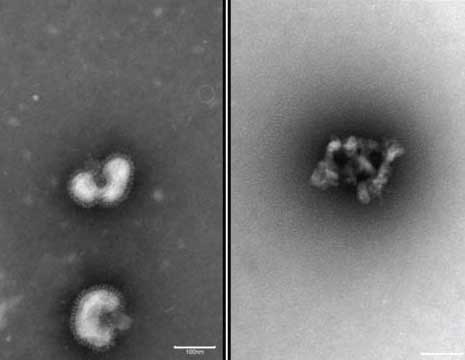New research from Emory University School of Medicine shows that a chemical in the mucus of South Indian frogs is capable of killing certain strains of the influenza virus. It will take a while for scientists to translate this finding into a useful medicine, but the discovery could lead to an entirely new source of powerful anti-viral drugs.
The skin mucus of the South Indian frog Hydrophylax bahuvistara contains a compound that kills bacteria and viruses. (Credit: Sanil George & Jessica Shartouny)
Skin slime from the South Indian frog Hydrophylax bahuvistara contains a compound that kills bacteria and viruses, according to a study published today in the journal Immunity. In tests on mice, a synthesised version of the molecule was successful at killing a variety of influenza viruses, namely the H1 pandemic strains that make the rounds each year. Eventually, a drug inspired by this compound could be used to attack an emerging H1 strain, or it could be used when vaccines are unavailable.
Unfortunately, this compound, dubbed “urumin”, doesn’t last very long in the body, so scientists are now trying to figure out how to make it more stable. That said, the discovery shows that amphibians, and possibly other animals, are a potential new source of disease-fighting compounds. The researchers who led the study are hopeful that similar frog-derived molecules can be used against other viruses, such as dengue and Zika.
Frogs can’t catch the flu, but they’re susceptible to bacterial infections and other diseases. Consequently, the Emory scientists had good reason to suspect that certain peptides produced by frogs — peptides are short chains of amino acids that form the building blocks of proteins — packed an anti-viral punch.

Left: The flu virus before exposure to the peptide. Right: The virus as it appears after exposure. The peptide attaches itself to the virus and literally dismantles it. (Image: David Holthausen)
“Peptides derived from the skin of frogs have antibacterial activity. We hypothesised some peptides might also have antiviral activity and hence we tested them against flu viruses,” said lead researcher Joshy Jacob in an interview with Gizmodo. “The frogs secrete this peptide almost certainly to combat some pathogen in [their] niche. The flu virus most likely shares a common motif with whatever the peptide is targeted to.”
Indeed, the peptide seems to be pretty good at attacking influenza. It attaches itself to hemagglutinin, the major protein on the surface of influenza virus, resulting in the dismantling and eventual death of the virus.
Some anti-bacterial peptides work by punching holes in cell membranes, making them toxic to mammalian cells, but fortuitously, urumin does not, according to observations the researchers made using an electron microscope. Tests on mice showed that the compound was effective against dozens of H1 strains, including the 2009 pandemic strain, but not against H3N2 and other flu strains. Looking ahead, the researchers will have to show that the compound is equally effective and safe in humans.
“This peptide works against all influenza viruses of the H1 hemagglutinin subtype because it binds specifically to a conserved piece in this protein,” explained Jacob to Gizmodo. “The peptide does not kill other flu viruses because they lack this conserved piece in hemagglutinin.”
The good news is that urumin can be synthesised chemically, so we don’t need to harvest fleets of frogs to extract large quantities of the stuff. The bad news is that our bodies are really good at breaking down and getting rid of foreign peptides. Stabilising frog peptides in the human body will be a challenge, says Jacob, “but we are currently working on it.”
One of the more incredible aspects of this study is how easily this peptide was discovered. Typically, the process of drug discovery involves screening thousands or even millions of candidates before a promising compound appears. For this study, Jacob’s team screened for 32 frog defence peptides against the flu, and found urumin with relative ease. “I was almost knocked off my chair,” Jacob said.
Excitingly, all animals seem to make at least a few antimicrobial defence peptides. This study may be a sign of things to come as scientists discover that nature has already invented the cures to some of the world’s worst diseases.
[Immunity]
